The Listening Room, Ikon Gallery A gallery installation and an offsite project. 23 September - 9 November 2003 Installation notebook |
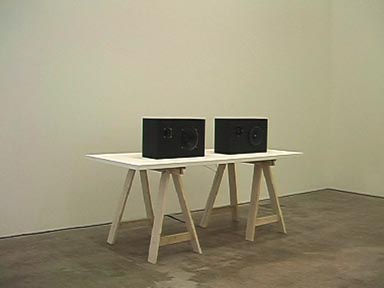 |
Friday 7nov03
Further documentation with DV cameras and a DAT recorder in the galleries. Saira, Ikon's education curator let me know in advance that a large student group was visiting, as I was hoping for a recording which included a fairly large number of people in the space.
There were two groups, after the gallery visit I gave a short talk to each group. Two different talks. I had to do this because giving the same talk twice plays tricks with my memory - I tend to forget if I've already made a particular point and rather than worry that I'm repeating myself I am liable to leave out key points. The way around this is obviously to talk from notes but I find it more interesting to improvise a different talk. Which allows flexibility - these student groups were primarily geography students, taking in my installation between the more obviously geographically relevant Ahlam Shibli and Turner's Britain at the City Art Gallery. So to try and make it relevant to geographers - I describe the way that the sound can map a space in a way which is significantly different to the space we might see, how low frequencies pass through surfaces of low densities, how high frequencies reflect off the same surfaces.
Another speculation - this is music that could only be presented in a gallery.
Thursday 23oct03
A screening at The Electric Cinema in Birmingham. This is a great old-fashioned cinema, good projection quality and good (mono) sound. The purpose built cinema has a long history and these days struggles along with some difficulty.
part 1 Non-Places - Brad Butler and Karen Mirza - (1999) 15 mins Jesus Blood Never Failed Me Yet - Steven Dwoskin (1971) 30 mins Reversal/Rotation (from the Functional Action series) - Tony Sinden (1975)10 mins part 2 Confessions - William Raban (1997) 1 min <-> (Back and Forth) - Michael Snow (1968-69) 52 mins |
In the interval I gave a short talk trying to relate this selection of artists' films to the Ikon installation work. The common factor is to take a very simple idea and amplify it. To pursue something (which may appear trivial or meaningless) so rigorously or relentlessly to the point where it becomes manifest in a completely new way.
Screening notes: What this selection has in common is an emphasis on the spatial relationship of a camera to the location, constraints of fixed cameras, choreographed cameras, cameras out of the control of the artist - a series of strategies to reveal something other than simple documentation. All this is in a context of of explorations of time ranging from the constraint of a continuous take (or even slower in Dwoskin's case) to the hyper-rapid cutting of Snow's <->. William Raban makes the camera do a bunjee jump - the duration of the film is dictated by the action, the camera movement is controlled by the laws of physics. Michael Snow creates a sculptural event through camera placement and mechanical process whereas the sculptural element in Tony Sinden's emphasises the plane, his camera is employed to survey a surface (a bowling green, very flat) using a figure 8 movement, this superimposed upon itself, choreographed. Butler and Mirza fix their camera in various locations, allowing the play of light and passing pedestrians to define the space. Dwoskin's fixed high speed camera choreographs an everyday scene, a man walking. A secondary common emphasis in this work is the viewing situation. No obvious solution is given to the viewer - the viewer is asked to participate in the work - whether through the physicality of viewing Snow or Raban on a large screen or the more contemplative aesthetic of Dwoskin and Sinden. Butler and Mirza shift the context of images with subtitles, leaving the viewer to question what emotional loading to apply to both image and text. It could be argued that a sense of tragedy/comedy or beauty in Dwoskin's film is imposed by the viewer on an otherwise neutral documentation (although that argument could easily be opposed through Gavin Bryars' soundtrack which leads the viewer into exactly that territory). Sinden's seductively green field of vision has a aesthetic consideration but again, nothing much appears to happen in conventional filmic terms - the viewer implicitly constructs their own experience of the film. Impossibility - something that the artist couldn't or wouldn't do - Raban's 'Confessions' derives from the artist's understandable reluctance to dive off a high tower, human perception of slowed time is an impossibility as is the act of walking for Dwoskin who has suffered from severe restriction on physical movement since childhood. Snow and Sinden could not physically perform the actions they make the camera do - in Snow's work the danger of repetitive strain injury or worse, in Sinden's film the motion is similarly impossible for a human unless weirdly levitated, this quality emphasised by the superimposition. Soundtracks - as a composer I am expected to mention the soundtracks. Butler and Mirza and Snow use location sound, in Snow's case the camera and back and forth mechanism audible in the space. Sinden uses location sound although manipulated in a way analogous to the filmic treatment. A tiny fragment of this treatment (or something very similar) reappears within Raban's 'Confessions' but the soundtrack here is music, initially a direct contrast to the violent physicality of the screen image but as the motions of the camera become more extreme, almost illustrative. Gavin Bryars' 'Jesus Blood Never Failed Me Yet' is a notable work in its own right - a unique balance of the experimental vocabulary of tape loop repetition, human repetition, process and imperfection in a context of finely-judged instrumental scoring. (Bryars has noted that the film is a visual track to the music, since the music was written first). |
Tuesday 13oct03
Maintenance of Gallery 4, cleaning the mic connections and power supply has increased high frequency response. With a bit of luck this may signal the end of the intermittent level drop problem. The microphone is 21 years old, first used on the violins on The Draughtsman's Contract. Perhaps it is getting old.
Wednesday 8oct03
Another attempt to record the installation with two cameras in galleries 4 and 6 and dat tape in gallery 5. It is a key element that the documentation includes the relationship of the space to the viewer - hence the recording of visitors to the gallery. My first attempt to cover as much of the space as possible using two cameras led me to place the cameras so that they were visible to anyone entering either gallery. One of the invigilators reckoned this was intimidating some potential visitors, perhaps to the extent of scaring them away. So I moved the cameras. Always the problem with an 'empty' space - in Tokyo the space was relatively small and the presence of a camera very intrusive so the documentation contains a number of people playing to the camera, making faces at it or adopting odd poses. |
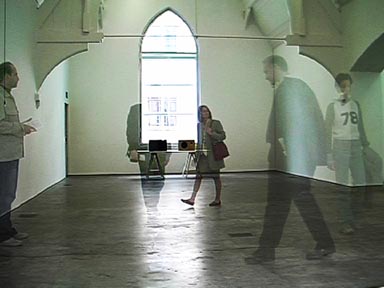 gallery 6 |
Towards the end of the planned recording the intermittent fault in gallery 4 returns and the gallery goes silent for the first time in a week. It is immediately reactivated by Matt the technician accidentally touching the microphone before I have time to check the signal chain. We decided to swap noise gate and mixer when the gallery closes at 18.00.
At around 17.58 the intermittent fault in gallery 4 returns so this is a unique opportunity to track it down. There is still signal coming through the system as normal but the microphone gain seems to have dropped by about 6dB. I could demonstrate this by turning up the mixer output by 6dB which caused the galley to behave normally again. My current theory is that it might be something to do with the power line for the microphone. Unlikely to be the mixer because the same power supply powers both galleries. So swapping a lot of equipment over (with the consequent need to re-tune the installation) would probably be an over-reaction under the circumstances, the solution is to clean all connections and see what happens.
Tuesday 7oct03
Returning from Berlin (for the highly accomplished and very enjoyable first performance of Martin Creed's new band) via London to Birmingham.
On entering the Ikon I am aware from downstairs that the pitch of gallery 4 has changed. Not for the worse - it is quite beautiful and bell-like, harmonically richer than the initial setup. I've never known an installation change like this and I don't know why. I will be recording the installation again tomorrow, the comparison with the recordings made on 25th September will reveal the extent of the shift. It is still in the same tuning relationship with gallery 6 and gallery 5 in between is the place to be as far as I am concerned. The inviligators always sit in gallery 5. Trust them.
Today a talk with students from Newcastle University visiting the gallery. Their questions are perhaps more interesting than my answers and a few lead me into interesting territory:
"What is the next step?" My technical answer referred to Clerkenwell Magistrates Court, the triple system, but my 'artistic' answer was to refer to the next available space. I went back to an extrapolation of the remark about trees in my writing on the first public Listening Room at the Chisenhale Gallery in 1994: '...looking at a tree - you don't look at every branch and leaf individually but they're all there if you want to look closer, you can enjoy a very different sense of ordering (in comparison to a man-made artefact) just by recognizing the generality of tree and the variations of the generality and the specific.' Today I compared the installations to trees in the sense they all depend on the same principles yet are individual and uniquely different.
Each one reveals new qualities and this ostensibly simplistic and often delicate work seems to thrive in the most stubborn circumstances. Assuming I have time to set it up and work with it - the Mailbox Lift Corridor installation suffered from an extremely restricted setup timetable and I regard this as a failure brought about not only by the situation but by my lack of judgement. Although given time it might have revealed itself differently.
A question about Cage made me discuss the difference between Cage's indeterminacy (one of his many great contributions to our world) and the idea of non-intentionality introduced to me by Alvin Lucier (see Monday 14jul03 from the Tokyo notebook). The difference is that the structure of the work is governed by a physical fact, acoustic or some other system of balance borrowed from the physical world.
A discussion with Matt, Ikon technician about the gallery 4 problem which has not returned for a week.
Matt: "If it ain't broke don't fix it." Years of experience force me to agree with this.
Around 5.30 gallery 4 went silent again. A sharp handclap near the microphone restored the situation. This is almost certainly a component fault within the noise gate or mixer but is it really worth disturbing a good sounding but relatively delicate electronic setup to attempt to fix it properly?
Monday 29sep03
| The intermittent fault in Gallery
4 has returned. I was around the gallery most of Thursday
to confirm that we had fixed it on Wednesday (when it first
happened).
But of course it was behaving that day. The rest of this is for the technically minded: It could be a component fault within the mixer as the signal is already going through a replacement gate. Switching the whole system off and on would probably restore the signal. Interim fix 1 - replace the jack leads from mixer to gate (output 4 to gate input and gate output to mix input 6 for gallery 4). Clean the connections with aerosol AF spray or similar. |
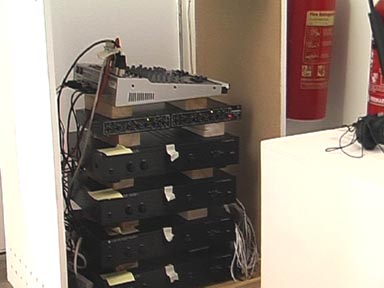 gallery equipment |
In addition - clean all relevant connections in this chain with aerosol AF spray including the amp inputs. Pull out the XLRs in the mic chain, spray the connections and replace. From dealing with the fault before I think this is unlikely to be the cause as the mic signal was definitely coming in but it could be a different fault, the first time complicated by the intermittent connection between mixer and amp.
The installations in Tokyo closed yesterday. My thanks to curator Minoru Hatanaka and the ICC team for their wonderful support.
Friday 26sep03
A notice has been put up in the former site of the Lift Corridor installation in the Mailbox shopping centre.
Due to circumstances beyond our control, the David Cunningham sound installation is no longer operating. We apologise for any inconvenience caused.
Cunningham's installation The Listening Room is currently on show at Ikon Gallery in Brindleyplace, a short walk from here. The gallery is open Tuesday * Sunday 11am-6pm. Admission is free. Telephone 0121 248 0708 for more information.
Such is the state of things that the builders will almost certainly move this notice as well.
Thursday 25sep03
After an overnight test and a day open to the public I am reassured that the gallery installation is running well. Today spent on preliminary documentation of the installation with video and a surround sound technique that I am trying for the first time. As recording continues I'm listening to it while writing a troubleshooting manual for technicians should anything go wrong in my absence.
But an afternoon visit to the Lift Corridor installation in the Mailbox shopping centre revealed that the builders had returned resulting in much disruption to the cabling and the appearance of the space. After meeting with Mailbox representatives onsite, Ikon curator Mike Stanley and I decided that it was impossible to attempt to sustain a compromised installation on a day to day basis under these conditions. So the plug is pulled and the offsite installation closed.
Wednesday 24sep03
Today my schedule was supposed to be a quick run-through any possible problems with the gallery technology with Matt the Ikon technician and an afternoon refining the Mailbox Lift Corridor installation and documenting the installation. I was spending a quiet slow morning reviewing tapes of the Lift Corridor to decide on the kind of sound settings that might work best in context. The phone rings and I have to run to rescue the gallery installation, half of which has mysteriously gone silent. The fault is intermittent which means methodical checking of each part of the signal chain - tedious and slow. The fault was mis-diagnosed about three times until finally I found an intermittent connection. |
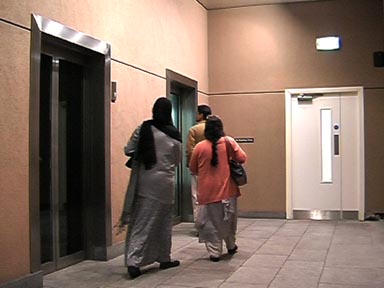 lift corridor |
The gallery is reopened just in time for a large visiting group, my computer (which has been supplying test signals) crashes and I go off to work at the Mailbox. It is still working but the builders have been in sometime this morning and removed the signs facing the lift, leaving a microphone cable hanging loose. The Mailbox building schedule is the reason the overall duration of the installation has been shortened. We had been told that any building work would start with the opposite wall but obviously something else is going on. Any retuning and documentation is delayed until the mic is moved. The watching and waiting leads me to think that the system is set fairly well for the situation. I made a tiny re-tune of the levels and start the videotape. My Ikon assistant today is Natalia who has a background in film and helps with camera position and framing - the result is a noticeable improvement on my own rather non-visual functionalist aesthetic, could be a good documentation.
Back to the gallery where the intermittent fault recurs just before closing. Matt and I go well into overtime trying to track it down. We change a noise gate and leave everything running overnight to see if we've cracked it. Exhausting.
Tuesday 23sep03
The opening of the exhibition. An early morning visit to the Mailbox installation. It is much as last night but maybe too quiet. In the meantime one of the gallery mics fell off the wall overnight. Easily fixed but my remedy involved better positioning of the PZM mic so that the response improved. The fix was done while I was out of the building for a few minutes and created panic as evil high-frequency feedback from the improved position swamped the galleries. |
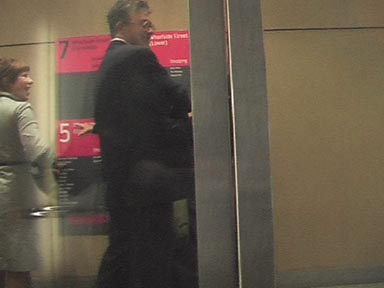 lift corridor from inside lift |
In contrast the gallery copes reasonably well with the number of people at the opening. This is unusual (see notebook for 10 July 2003, http://www.stalk.net/piano/icc01.htm). Downstairs in the first floor gallery are the superb photographs of Ahlam Shibli. They are clear, simple and the viewer is empowered to understand as much of the process as they choose. And totally different to my work. I like the combination.
Everywhere in the building except the gallery areas are Amikam Toren's 'Armchair Paintings', clear and simple and often very mysterious. I have one of Amikam's paintings in my studio in London.
Afterwards 'Where a straight line meets a curve' is shown twice at the Grand Hotel Ballroom. Brad and Karen have had a tough time with ambient light spill, projector malfunction and a fairly similar day to me. The projection is great, nice and bright with impressive sound.
Monday 22sep03
A morning setting up a surround version of 'Where a straight line meets a curve' prior to the lunchtime arrival of film-makers Karen Mirza and Brad Butler to set up the projections. Afternoon is final resetting of the gallery work following movement of all equipment out of the gallery spaces. Following the the Lift Corridor installation test, tonight we installed. A very slow process. Mics, speakers and equipment have to be fixed in place and cables made safe from trip hazard and possible vandalism. Mics were fixed in position and following a brief test I decided to put the speakers high up on the walls. Difficulties drilling through the walls and getting cables through slowed the installation of the installation. The necessary holes drilled and cables were mostly in place by about 23.00 when I started tuning the work. |
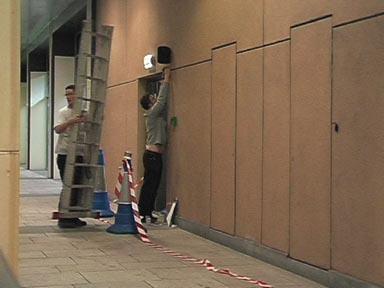 installing |
One consideration is not to repeat the Tokyo stairwell. I can do something like that with this space but it is not appropriate here - I don't want people to walk into a wall of (slightly scary) noise. The situation has to be open, dictated by the environment, not an autonomous situation. But what is the environment? Midnight in a shopping centre is not the same as other times. I've spent a lot of time in this space and the use changes significantly and often unpredictably. But I've never been in this part of the space at midnight before.
23.00 after a long day is too late for me to tune something like this - it is akin to performing. I tuned it to do something slow and quiet, overtones of avant-garde music. It is supposed to be finished but it isn't. I should have reached this stage with this installation a week ago. I don't really know how this will behave, either when the equipment has warmed up and settled in (it does make a difference) or more significantly, how it will behave for a 24 hour period. This problem has something to do with my ambitions for the work contrasted with the practical possibilities of this situation.
Sunday 21sep03
Tonight was the first chance to test rig the Lift Corridor installation in the Mailbox shopping centre - with the help of Matt and Mike cables are draped around the space and mics and speakers roughly put in position. The installation amplifies two sections of the corridor into each other. The two amplified sounds interfere with each other, are at feedback level and are under the control of noise gates - another double Listening Room, a similar structure to the stairwell at ICC but on a level plane. |
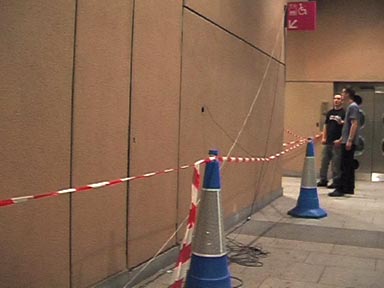 testing |
The work is part of a context - a gallery provides a safe situation where anything is possible and the visitor arrives with that expectation. Walking through a public corridor is quite a different situation - I want to be careful not to impose. Allowing something to happen is a key aspect of this work and that involves co-existence, not confrontation. A major concern is volume - from the way it was sounding in the space tonight quieter is better. I really need to hear it in the daytime.
Friday 19sep03
More refinement and presentation - the painting of tables (white) and some speakers (black) and running cables through impossible routes to become invisible to the viewing public. One problem with this work (to which I currently have no solution) is how to make the technology transparent, as opposed to invisible. An arts graduate in Britain will generally be oblivious to the laws of physics - to explain the simple technology at work and why it does what it does is generally hard work if not impossible. Some science graduates are not any better. I find it simplest to hide the wires so that the attention of a viewer or participant in the installation is not visually distracted. Especially in an art gallery, the visual is prime - how do you get people to listen? |
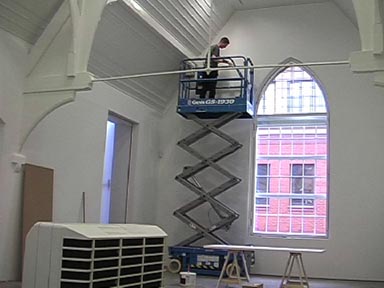 fixing cables |
In the middle of this commercial reverie I am interrupted by Jonathan Watkins, Ikon's director (and the curator who generously created the opportunity me to make the first public Listening Room in 1994), who reckons I have beaten the minimalist record set by Ceal Floyer for putting as little in the gallery as possible. This is correct - I have managed to leave Gallery 5 (between the two installations) completely empty apart from the air within the space (which carries the sound from galleries 4 and 6). Since I started trying to make this work in galleries I have wanted an empty space, devoid of loudspeakers and technology or anything other than the sound.
Ceal's agenda is different but similar, simple ideas, complex in their implications. I missed what (I believe) was her only performance ever - an Ikon Offsite project with CBSO in Birmingham - I was playing guitar with Scanner in Oslo.
Thursday 18sep03
| Refinement and presentation - the
tables for the speakers arrived today. Next step
was to place speakers in the exact position for the exhibition.
Significant factors include not only the position of the speaker
in the room but the nearby surfaces - the surface of the table will to
some extent reflect sound and this affects the feedback. My urge to fiddle with the installation is irresistible - it is stable and simple and easy to revert to the initial settings and positioning. This is a gift from the original architect(s). I tried placing a second microphone in the Gallery 6 installation to spread the acoustically active field within the space. This lifted the pitch of the feedback by an octave but the result is similar to the Gallery 4 frequency - the overall relationship of the double installation is less interesting. |
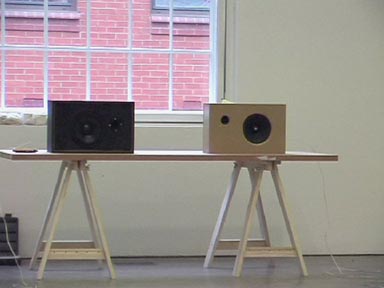 2 speakers in position |
Wednesday 17sep03
| By noon the two Listening
Rooms are in position and running in Galleries 4 and 6 with cables
trailing everywhere and mixer and amps positioned in Gallery 6 so that
I can hear everything as I tweak levels . Both installations are
basically sounding good independently but when both are run together
the
relationship between the two spaces that I was hoping for
is immediately obvious. The two rooms phase in and out
of sync, neither dominating even though Gallery 6 is relatively quiet.
The acoustic relationship of the two Galleries is clear in
Gallery 5, the space between. Strong because
the intrinsic acoustic qualities of the spaces arise from the well
proportioned architecture of quite a special building, originally a
school built in 1877. Very little tuning of the system
is needed, I have to resist the urge to fiddle. Sounding quite
unlike the test I made of this variant in Newcastle this April. |
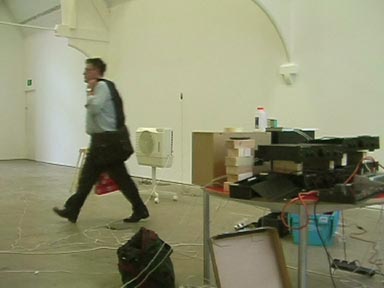 Gallery 6 |
In the afternoon a visit to the Mailbox shopping centre where we refine decisions on positioning of equipment and cable runs.
| Tuesday 16sep03 A beautiful sunny day in Birmingham. Today I began building the gallery installation with the invaluable assistance of Ikon technician Matt. Starting in Gallery 6, the larger of the three that I am using, a mic, gate, two amps and four speakers begin to shape themselves into a classic Listening Room. Except that initially it sounds horrible, probably the equipment warming up. Things improve and slowly the system finds the sound of the room. |
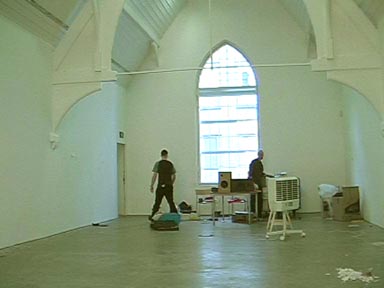 Gallery 6 |
Mailbox installation problems continue. The building managers do not seem to understand that the work (which they think of as art and I don't necessarily) is effectively part of the building and installing is a process that involves time and consideration. Mike is doing all the hard work, negotiating, gently persuading - seems to be getting somewhere - which requires superhuman effort - I begin to realise the difference between having had a degree in Fine Art 25 years ago and otherwise. I graduated from a very good degree course with the certainty that I knew nothing of any apparent use. It is only when one begins to deal with the everyday world that such a suspicion is proved correct. This involves dealing with people so deluded by circumstance that practicalities don't exist. 'Art' is a magic commodity, part of a contemporary retail environment as much as any shop or restaurant. Stick it on the wall, a kind of visual muzak.
This problem led me to Mailbox in the first place - Birmingham is rich with public art - quality aside - when I was location hunting every time I heard a trace of an interesting echo I would round the corner to be confronted by something, for instance: a massive pink heart executed in aluminium on an adjacent wall. Certainly public but the art value is open to discussion. Not next to my stuff. Please... Mailbox was open, empty of this nonsense. Now I know why.
Thursday 14aug03
On Monday the Mailbox people told Mike at Ikon that the designated installation space, the lift corridor on level 7, would not be available in September because of building work. This is the second time this has happened within a couple of months - Mailbox decided to put glass doors in the original location.
So today I am in Birmingham to try and find an alternative. Ikon print deadlines are imminent and it is going to be very difficult to find somewhere suitable and obtain permissions etc. Today's news is that there may be a reprieve - the building work may not start until October. Waiting for confirmation - I'd rather do a good piece for a week than something compromised for 6 weeks.
Karen Mirza came with me, we also visited the Grand Hotel Ballroom, an enormous space where we plan to show 'Where a straight line meets a curve' during the exhibition. The space is superb - curious that such a wonderful central site is empty when the rest of the city is furiously building new developments.
Walking through the corridor site today was fascinating, I could hear the ambient noise reflecting off the different wall surfaces very clearly.
| Friday 18jul03 A meeting with the Mailbox management. I wasn't too worried about the glass doors until today when I discovered that this means one set of doors right in the middle of the space. For some reason I had assumed that there would either be a set at the street entrance or a set inside or both. The proposed position of the doors will obliterate the acoustic qualities which had originally drawn me to the space. Neil from Mailbox mentions there is another possible space. We visit. It's pretty good, a glassed-in corridor leading from the lifts to the shops on the top floor of the shopping area. |
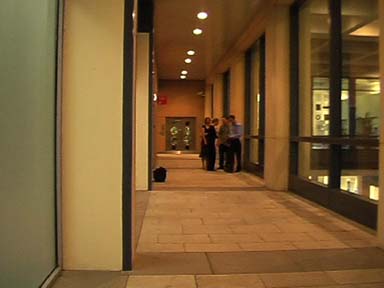 Mailbox lift corridor |
Tuesday 8jul03
The Mailbox management have decided that they are going to put glass doors in the space.
Thursday 12jun03
Mike writes from Ikon to tell me that the Mailbox building management are supportive.
| Tuesday 8apr03 Mike Stanley (Ikon curator) and I are applying to the PRS Awards to new works scheme for funding for the offsite project. Application deadlines mean an urgent decision about which site. The large-scale Victoria Square idea is too ambitious to pin down in the specific terms required for an application - I haven't thought through the technology, we don't know about permissions to use locations or what building work is scheduled for the area at the time of the proposed work. So my decision is to go for the Mailbox shopping centre side entrance, a peculiar resonant box of glass and reflective walls. |
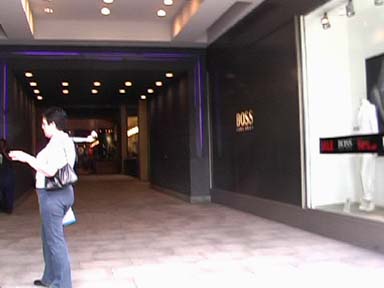 Mailbox side entrance |
I've already spent many days and much shoe leather exploring the central part of Birmingham between the Jewellery Quarter and Digbeth looking for locations over the last year. There is so much building work going on that many possible locations are unusable. One of the most useful things was wandering around Digbeth amidst the chaos of the building sites and markets, getting a feel of the city, thinking about a relationship to the noise which permeates the city.
After much consideration of possibilities and practicalities I'm considering the following options:
1) canalside
2) cemetery
3) Mailbox
4) Victoria Square
The canalside location somewhere beneath the Telecom Tower was very promising but is pitch dark at night, becomes quite an intimidating part of the canal path.
When I was thinking over the cemetery - an amphitheatre shape in the Jewellery Quarter, I started thinking of Victoria Square as another (un-natural) amphitheatre. The idea of applying sequenced amplification to the space, using the buildings as a (very very rough) kind of lens (as I was thinking for the cemetery) to the Square itself, some mics somewhere around the North building (museum?) and speakers at the corresponding sides, East (not sure what that is) and West (library). (The library might get demolished - there are constant rumours about development in this city). I tried to work this out on the train - my map is rubbish, scale is too small, I can't remember exactly which building is which because I never considered the idea when it was right in front of me.
This engages with the city rather than hiding from it. The scale is maybe too much. Would need to be significantly louder than the other options but not outrageous. But technically and organisationally fraught with difficulty because it is such a busy location.
return to:
Ikon Gallery Installations
Installations
Activated Space